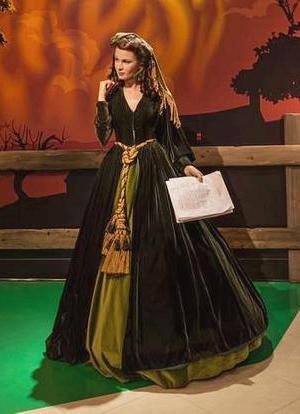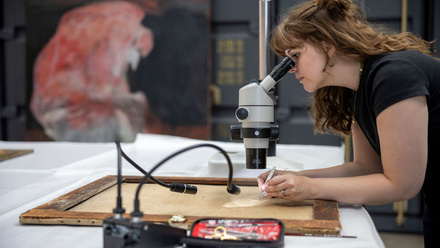It's just a dress!
When Kim Kardashian wore Marilyn Monroe’s dress to the Met Gala, social media erupted. Some people were shocked that the dress was allowed to be worn, others shrugged their shoulders: "Who cares, it's just a dress. Isn’t clothing meant to be worn?”
We are delighted to announce that the 2022 Icon Annual Lecture will be delivered online by Sarah Scaturro, who will delve into the controversy surrounding Kim Kardashian and the Marilyn Monroe dress, the media furore that followed, and the ways in which conservation practice was thrust into the limelight. Book your ticket here.
Sarah Scaturro is the Eric and Jane Nord Chief Conservator at the Cleveland Museum of Art. Previously she was the Head Conservator at the Costume Institute, Metropolitan Museum of Art. She is a doctoral candidate at Bard Graduate Center writing her dissertation on the development of costume conservation in the US and UK during the 20th century. Her thoughts about Marilyn Monroe’s dress being worn by Kim Kardashian were carried by media like BBC, the LA Times, NBC, Diet Prada, Dressed: A Fashion History podcast and more.
Ahead of the lecture, Sarah shares some thoughts on the subject.
How did you find out about Kim wearing the dress and what was your immediate reaction?
I found out like a lot of other people who didn’t watch the actual event – I was looking at footage of the red carpet the following morning on Vogue.com.
My first thought was “Who is that blonde bombshell? What great pointy boobs!” And then when I read it was Kim Kardashian, I thought, “Huh, such a shape shifter.”
And then I further read that she was wearing Marilyn Monroe’s real dress and my stomach dropped as I felt dismay and frustration. I felt so powerless.
How ironic that a benefit intended for the preservation of costume meant that one of the most iconic pieces of American fashion history was damaged.
I was also saddened at how money and power can enable some people to bypass professional and ethical considerations in the preservation of cultural heritage for their own personal gain.

Are you worried that moving forward, colleagues in costume departments will be pressured to allow historic garments to be worn?
Absolutely, as a fashion conservator I understand that this was a dangerous precedent to set.
People ask us about the possibility of wearing historic clothing a lot more often than you would think – and I understand why, as clothes are meant to be worn! So rather than be annoyed, it’s an opportunity to educate people about the risks inherent in fragile historic clothing being worn.
If someone higher in the hierarchy than the caretaker insists on a garment being worn – then there is not much the caretaker can do besides education and minimizing damage as much as possible.
I am worried that this precedent will mean that colleagues who are archivists, collection managers, conservators, and curators are pressured to allow historic garments under their care to be worn in circumstances where ethically it does not make sense.
People ask us about the possibility of wearing historic clothing a lot more often than you would think.
Just a few weeks ago, Lizzo was granted permission by The Library of Congress to play a 200-year-old crystal flute, once owned by former US President James Madison.
It seems that some conservation professionals are eager to find ways to move beyond absolute prohibition when it comes to handling artifacts. How do you think the discourse is evolving?
I loved seeing Lizzo play the flute! I agree that many conservation professionals recognize that absolute prohibitions are not helpful, and can in fact be harmful. Instead, we try to understand the context of the artifact and its values. We often use a peoples-based approach, in which we centre the values and needs of the peoples and communities whose cultural heritage it is or impacts.
In the case of the flute, it belongs to the American public, and the materials are much more resilient and less vulnerable than the fragile silk fibres of Monroe’s dress.
In fact, there is a tradition of conservators facilitating the playing of historic instruments in order to keep them in good operating condition. Besides a difference of material strength between the flute and dress, the context was also significantly different.
In one case there was a reclamation of Black female empowerment with Lizzo playing the flute of an enslaver, and in the other there was an abuse of power with Kardashian wearing the dress for nothing more than to fulfil her vision for how she would look on the red carpet for a party.
I loved seeing Lizzo play the flute! I agree that many conservation professionals recognize that absolute prohibitions are not helpful, and can in fact be harmful.
Conservation issues sometimes go viral, many times because of botched restorations (everyone knows Monkey Jesus). Do you have a favourite example of a conservation story gone viral?

Well, Monkey Jesus is probably the best example of so-called restoration gone rogue – visually it’s hard to top that!
But I would say the story of the Mask of Tutankhamun which had gotten broken and then re-adhered using industrial-grade epoxy was pretty shocking! I was relieved to read that the adhesive could be removed and then a proper treatment applied.
For fashion, I loved the story in 2011 of Cara Varnell conserving Vivian Leigh’s Scarlett O’Hara green curtain dress. The garment’s color was too faded to be restored appropriately and the story was a great example of how not just light, but chemicals (in this case, a disinfectant) historically applied to clothing can impact the color’s stability.
Book your ticket for the Icon Annual Lecture on 1 December to hear Sarah discuss how conservation issues can go viral and how conservators can engage these opportunities to communicate compellingly and with nuance the varied nature of conservation.
Members can book this - and a fantastic range of Icon events - for free! Become an Icon member today.






